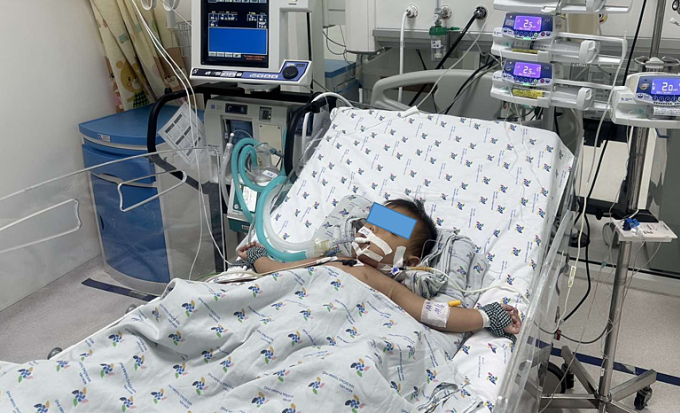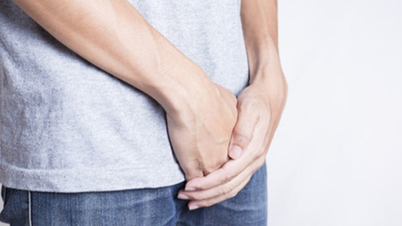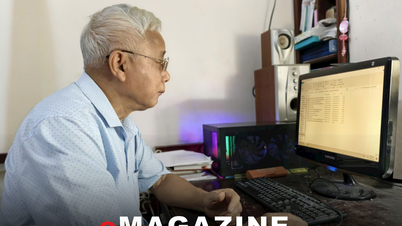The number of hand, foot and mouth cases has increased by nearly 150% in the past month, with many severe cases. The Ho Chi Minh City Department of Health is preparing three scenarios to respond to the risk of an outbreak.
Last week, the city recorded 423 cases of hand, foot and mouth disease, an increase in both hospitalizations and outpatient visits. 147 children, all under 6 years old, are being treated in hospitals. Of these, 18 children are seriously ill and need intensive care, 14 are on ventilators and one is on dialysis. To date, the city has recorded one death due to hand, foot and mouth disease.
Compared to the same period last year, the number of hand, foot and mouth disease cases has decreased by more than 53%, however, the appearance of the Enterovirus 71 strain with its fast spreading and highly virulent characteristics causing severe illness has made health officials concerned about the risk of an outbreak. To respond to severe cases of level 2a or higher, estimated to account for about 10% of inpatient cases, the Department of Health has prepared three scenarios for admission and treatment.
The first scenario requires 200 beds, of which 30 are intensive care beds, with less than 50 hospitalizations per day, less than 200 inpatients, and less than 20 severe cases. At that time, priority will be given to treatment at the city's three specialized pediatric hospitals.
When the number of hand, foot and mouth disease cases admitted to the hospital each day increases by 50-100, 200-700 cases are being treated as inpatients and 20-70 cases are in serious condition, Ho Chi Minh City will move to the second scenario . At that time, 700 beds (including 80 intensive care beds) are needed, with pediatric patients treated at three pediatric hospitals and the city's Tropical Diseases Hospital.
The third scenario is expected to be implemented when 100-200 cases of hand, foot and mouth disease are admitted to the hospital every day and 700-1,400 inpatients are treated, with about 70-140 severe cases. The total number of treatment beds is 1,400 (including 150 intensive care beds). The treatment system implements the process of classifying outpatients and inpatients, and assigning routes to avoid overload at end-level hospitals and minimize deaths.

A child with grade 3 hand, foot and mouth disease is being treated at the City Children's Hospital. Photo: Provided by the hospital
The Department of Health recommends that medical facilities prepare medicines and infusions, medical equipment and supplies for the three scenarios above. The city's upper-level hospitals provide professional support to lower-level hospitals and provinces in the region, avoiding unsafe transfer of patients to the city. Doctors at all levels set up a hotline to consult and decide on hospital transfers.
The problem that the Department of Health is concerned about is that seriously ill patients are transferred from other provinces and cities, while the drug supply in the city is limited. In early June, the Department of Health asked the Drug Administration ( Ministry of Health ) to support finding drug supplies and is expected to have the drugs in July.
Hand, foot and mouth disease is an acute viral infection, transmitted through the digestive tract, commonly found in children under 5 years old and has the potential to cause large epidemics. Symptoms include fever, sore throat, lesions of the oral mucosa and skin, mainly in the form of blisters on the palms, soles, knees, and buttocks. Most patients have a mild course. Some cases are severe and have dangerous complications such as meningitis and sepsis, which can lead to death.
Preventive measures include cleaning children's toys and the house with soap, Javel solution or common disinfectants. Early detection of signs of hand, foot and mouth disease in children to promptly isolate them and limit the spread. Severe symptoms include persistent high fever, vomiting, dizziness, shaking hands and feet, and taking the child to the hospital immediately.
America and Italy
Source link




![[Photo] Hanoi morning of October 1: Prolonged flooding, people wade to work](https://vphoto.vietnam.vn/thumb/1200x675/vietnam/resource/IMAGE/2025/10/1/189be28938e3493fa26b2938efa2059e)

































![[Photo] Panorama of the cable-stayed bridge, the final bottleneck of the Ben Luc-Long Thanh expressway](https://vphoto.vietnam.vn/thumb/1200x675/vietnam/resource/IMAGE/2025/9/30/391fdf21025541d6b2f092e49a17243f)
![[Photo] President Luong Cuong receives President of the Cuban National Assembly Esteban Lazo Hernandez](https://vphoto.vietnam.vn/thumb/1200x675/vietnam/resource/IMAGE/2025/9/30/4d38932911c24f6ea1936252bd5427fa)
![[Photo] The 1st Congress of Phu Tho Provincial Party Committee, term 2025-2030](https://vphoto.vietnam.vn/thumb/1200x675/vietnam/resource/IMAGE/2025/9/30/1507da06216649bba8a1ce6251816820)
































































Comment (0)